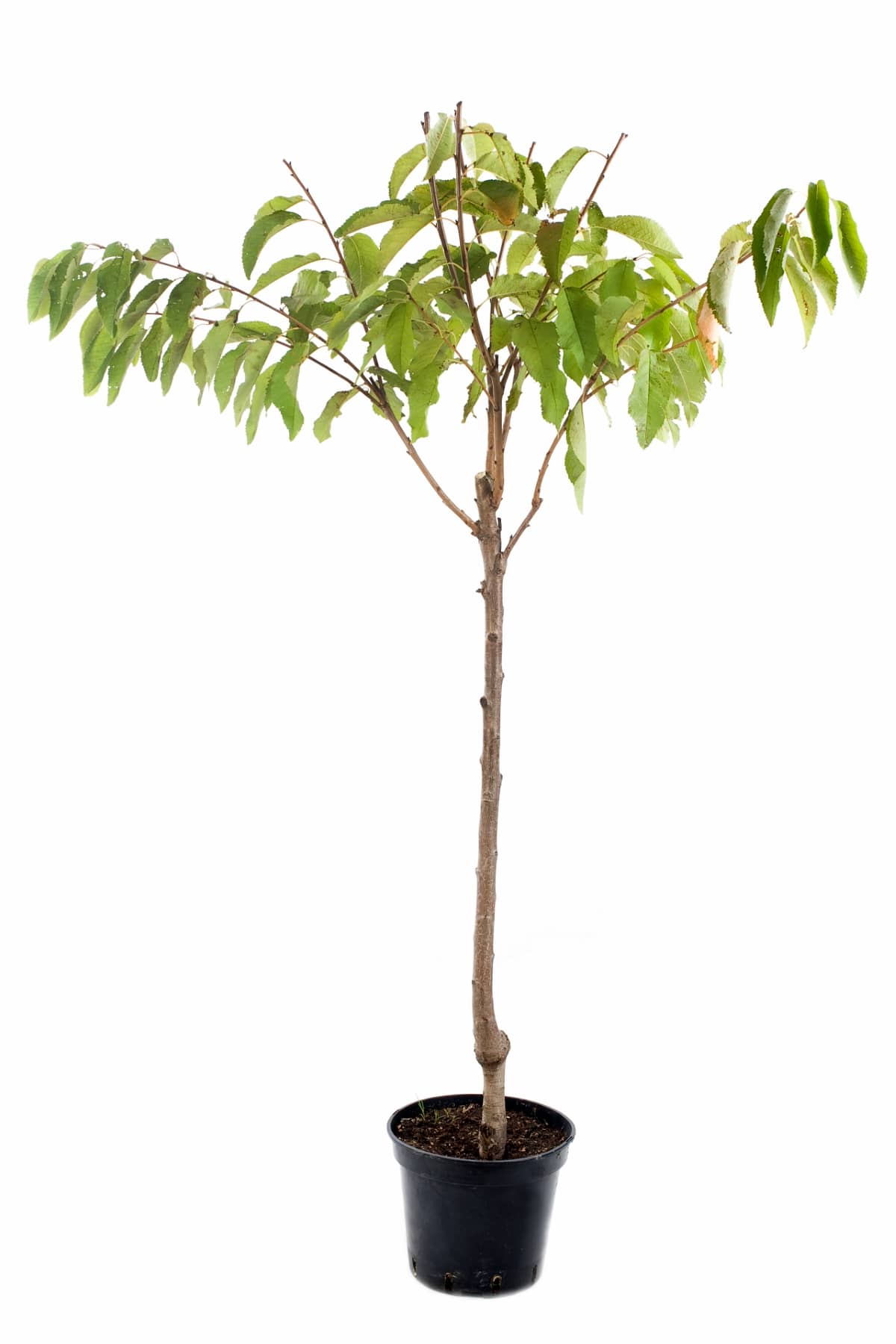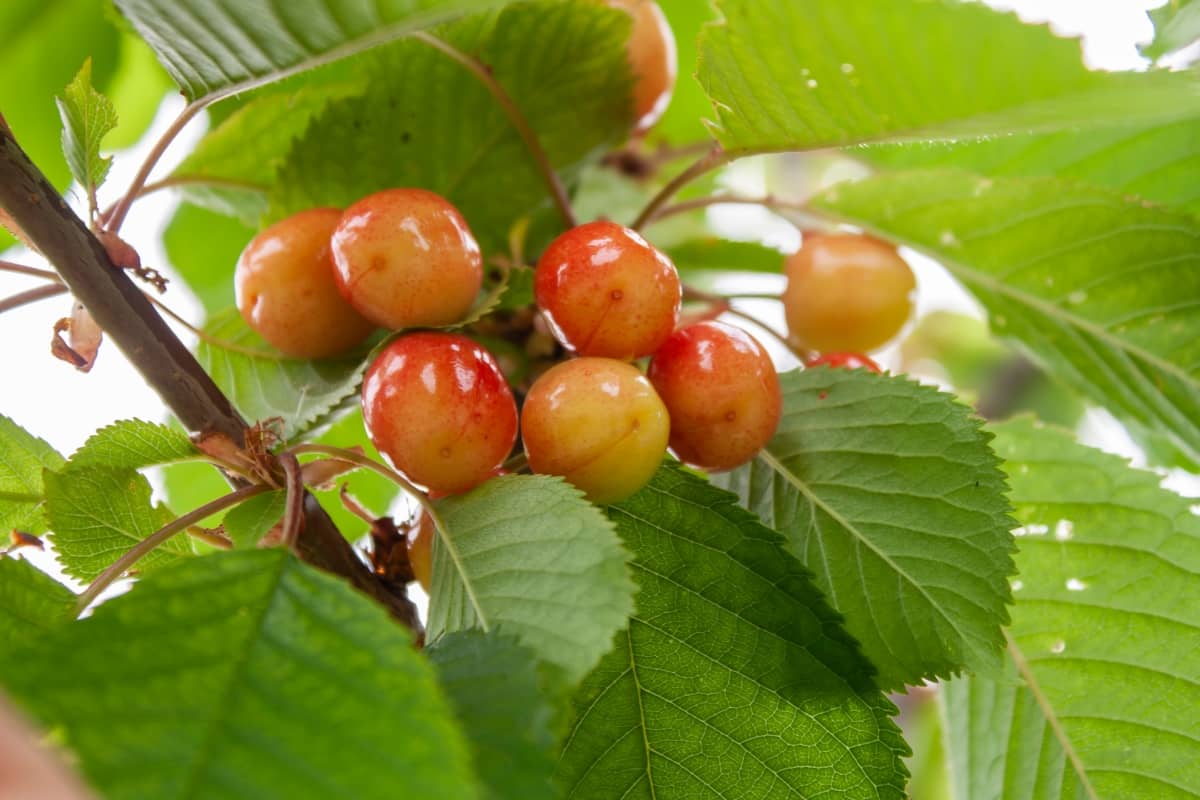Fertilizing potted cherry trees is an essential aspect of their care and maintenance. By providing the right nutrients, you can promote healthy growth, ensure proper fruit development, and enhance overall tree vigor. This article will discuss a comprehensive understanding of the importance of fertilizing potted cherry trees, along with the best practices to follow.

Fertilizing Potted Cherry Trees
Organic Fertilizers for Cherries in Pots: Nurturing Your Plants Naturally
Bone Meal: Bone meal is a slow-release organic fertilizer that provides a source of phosphorus and calcium. Cherries require phosphorus for root development and overall plant growth. Mix bone meal into the potting soil or apply it as a top dressing around the base of the plant.
Seaweed Extract: Seaweed extract is a natural fertilizer that contains various nutrients, including trace elements and growth-promoting hormones. It enhances root development, strengthens plants against diseases, and improves overall plant health. Dilute the seaweed extract according to the manufacturer’s instructions before applying.
Worm Castings: Worm castings are a nutrient-rich organic fertilizer produced by earthworms. They improve soil structure, increase nutrient availability, and enhance water retention. Mix worm castings into the potting soil or use them as a top dressing.
Comfrey Tea: Comfrey tea is a homemade organic fertilizer made from steeping comfrey leaves in water. It is rich in potassium and other nutrients, promoting fruit development and plant vigor. Apply comfrey tea as a foliar spray or use it to water the plants.
Natural Fertilizers for Cherries in Pots: For Environmentally-Friendly Options
Compost: Natural fertilizers like compost enrich the soil with organic matter and improve its health. Using kitchen waste, yard waste, and other organic materials, you can make your compost. Regularly adding compost to the soil around your potted cherry tree will ensure a steady supply of nutrients.
Manure: Well-rotted manure from herbivorous animals, such as cows, horses, or chickens, can provide an excellent source of nutrients. However, it is crucial to use aged manure to avoid burning the roots of the cherry tree. Mix the manure with the potting soil or apply it as a top dressing around the tree’s base.
Fish Emulsion: Decomposed fish are used to make fish emulsion, a liquid fertilizer. It has nitrogen, phosphorus, and potassium abundantly. They are essential nutrients for plant growth. Apply the fish emulsion to the soil around the cherry tree after diluting it according to the package instructions.
Homemade Fertilizers for Cherries in Pots: DIY Solutions for Optimal Plant Health
Banana Peel Fertilizer: A banana peel is a rich source of potassium, an essential nutrient for fruit development. You can make banana peel fertilizer by chopping up the peels and burying them around the cherry tree. Over time, the peels will decompose, releasing potassium and other beneficial nutrients.
Epsom Salt Solution: Epsom salt is a great magnesium source, which plays a vital role in chlorophyll production and overall plant health. Dissolve one tablespoon of Epsom salt in 4 liters of water and use it to water your potted cherry tree once a month.
Coffee Grounds: They are an excellent source of nitrogen, which promotes leafy growth. Sprinkle the coffee grounds around the cherry tree’s base, ensuring they are well-mixed with the soil.
In case you missed it: 9 Causes of Dying Cherry Trees and How to Fix Them?

NPK Ratios and Their Importance in Selecting Fertilizers for Cherries in Pots
These ratios refer to the amounts of nitrogen (N), phosphorus (P), and potassium (K) required by the plants. For cherries in pots, a recommended NPK ratio is 10-10-10 or 15-15-15. This means the fertilizer should contain equal parts of nitrogen, phosphorus, and potassium. This balanced ratio promotes healthy growth, strong root development, and abundant fruit production. It is important to follow the recommended NPK ratios to ensure optimal nutrition for cherries grown in pots.
Slow-Release Fertilizers: Enhancing Nutrient Availability for Cherries in Pots
Slow-release fertilizers are a type of fertilizer that gradually releases nutrients over an extended period. They are designed to enhance nutrient availability for cherries grown in pots. These fertilizers consist of granules or pellets that break down slowly, releasing nutrients such as nitrogen, phosphorus, and potassium to the plant roots.
This slow-release mechanism ensures a steady supply of nutrients, preventing nutrient deficiencies and reducing the risk of over-fertilization. Slow-release fertilizers benefit potted cherry trees as they provide a continuous source of nutrients, promoting healthy growth and improving fruit yield. Their long-lasting effect reduces the need for frequent fertilization, making them a convenient choice for pot cultivation of cherries.
pH Levels and Fertilizer Selection for Cherries in Pots: For Balanced Soil Environment
pH levels are crucial in maintaining a balanced soil environment for cherries grown in pots. The optimal pH range for cherry trees is between 6.0 and 6.8. This slightly acidic to neutral pH promotes nutrient availability and absorption, ensuring healthy growth and fruit production. Monitoring and adjusting the pH level is essential for preventing nutrient deficiencies or toxicities. To maintain the desired pH range, regular soil testing is recommended. If the pH is low, add lime to raise it, while sulfur is used to lower a high pH.
The Importance of Timing: When to Apply Fertilizer to Cherry Trees in Pots
The best time to fertilize cherry trees is in early spring, just before their active growth period begins. This allows the trees to benefit from the nutrients as they start producing new leaves and flowers. Applying fertilizer during this time helps to support vigorous growth and enhance fruit production. In addition to the spring application, it is advisable to fertilize cherry trees in pots two to three more times during the growing season. This can be done every 4-6 weeks, starting from early spring and continuing until mid-summer.
In case you missed it: How to Grow and Care for Cherry Bonsai: Planting, Pruning, and Repotting

How to Apply Fertilizer to Cherries in Pots: Techniques for Maximum Effectiveness
Before applying the fertilizer, ensure that the soil in the pot is moist. Water the tree thoroughly a day or two before fertilizing to prevent any potential damage to the roots. After that, sprinkle the fertilizer evenly around the tree’s base. Avoid applying the fertilizer too close to the trunk to prevent burning the tree. After applying the fertilizer, lightly scratch it into the soil surface using a small hand rake or cultivator.
This helps to incorporate the fertilizer into the top layer of soil, ensuring that the nutrients are readily available to the roots. Don’t disturb the roots or damage the tree while doing this. Once the fertilizer has been applied and incorporated, water the cherry tree thoroughly to help the nutrients penetrate the root zone. Watering also helps prevent any potential fertilizer burn and ensures that the nutrients reach the tree’s roots where needed.
Water-Soluble Fertilizers for Potted Cherry Trees
Water-soluble fertilizers are a convenient and effective option for feeding potted cherry trees. These fertilizers dissolve quickly in water, making them easy to apply and ensuring that the nutrients are readily available to the plants. Organic water-soluble fertilizers are also available for those who prefer natural products. Some popular options for organic water-soluble fertilizers for cherry trees in pots include seaweed extract, fish emulsion, and compost tea.
Best Fertilizer Application Techniques for Cherries in Pots: Dos and Don’ts
Dos
- Fertilization should be done in early spring before new growth appears.
- The soil should be moist prior to applying fertilizer to prevent root burn.
- Mix the fertilizer thoroughly with the soil to ensure even distribution.
- Water the plants thoroughly after applying fertilizer to help nutrients reach the roots.
Don’ts
- Do not apply fertilizer during the dormant period in winter.
- Do not apply fertilizer directly to the foliage, which can cause leaf burn.
- Avoid applying fertilizer very close to the trunk, as it can damage the roots.
- Do not mix different types of fertilizers unless specifically recommended.
In case you missed it: How to Treat Brown Spots on Cherry Tree Leaves Naturally: Causes, Fix With Effective Organic Home Remedies

Conclusion
By following these best fertilizer application techniques, you can ensure that your cherry trees in pots receive the vital nutrients they need to thrive and produce bountiful harvests. Remember to follow the dos and avoid don’ts to maintain healthy and productive cherry trees.
- Feed Your Flock for Less: Top 10 Tips to Save on Chicken Feed
- Ultimate Guide to Ossabaw Island Hog: Breeding, Raising, Diet, and Care
- Hatching Answers: The Top 10 Reasons Your Chickens Aren’t Laying Eggs
- Eggs and Economics: Breaking Down the Cost of Raising Backyard Chickens
- Defend Your Greens: Proven Methods to Keep Iguanas Out of Your Garden
- Ultimate Guide to Cinnamon Queen Chicken: A Comprehensive Guide for Beginners
- Ultimate Guide to California Tan Chicken: Breeding, Raising, Diet, Egg-Production and Care
- Ultimate Guide to Marsh Daisy Chicken: Breeding, Raising, Diet, and Care
- 10 Types of Chicken Farming Businesses You Can Start for Profits